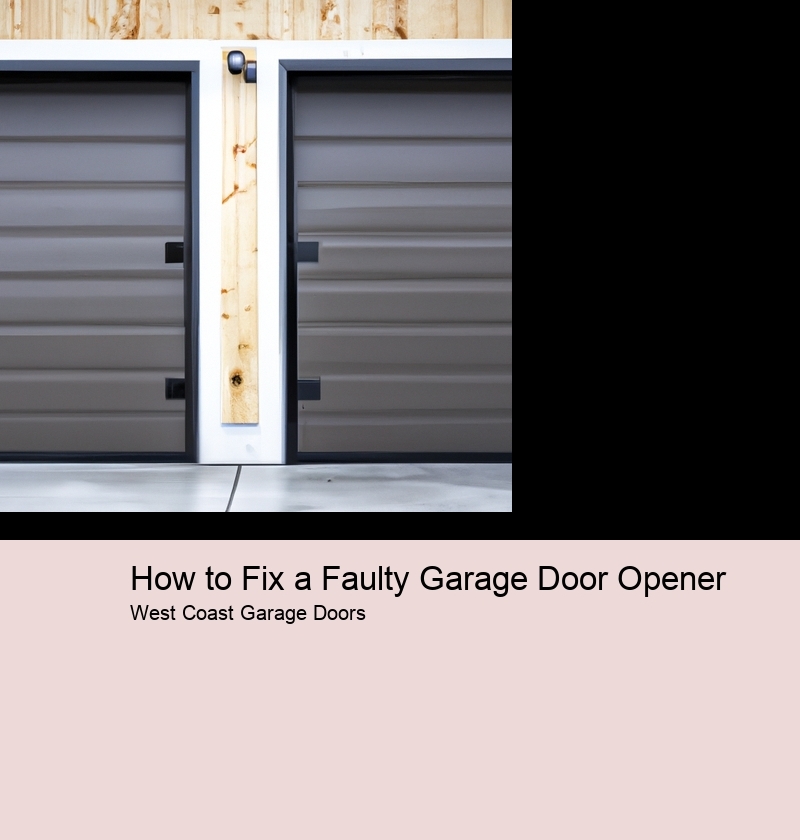How to Fix a Faulty Garage Door Opener
Patient
Identify the problem with your garage door opener
Identifying the problem with your garage door opener can be a difficult task.
How to Fix a Faulty Garage Door Opener - emergency service
- drive belt repair
- garage door tune-up
- Carriage house
- weatherstripping installation
Gather the necessary tools and supplies
Fixing a faulty garage door opener can be daunting, but with the right tools and supplies, it's definitely doable. Start by gathering the necessary components: a screwdriver, pliers, lubricant, a new circuit board if needed, and any other specific parts that may be required. Next, disconnect the power source to ensure safety while working on the opener. Then, take apart the unit and inspect each component for damage or wear. If you find anything broken or worn out, replace it with new parts. drive belt repair Finally, apply lubricant to all moving parts of the garage door opener before reassembling everything and reconnecting its power source. With these steps completed your faulty garage door opener should now be up and running again!
Unplug the power source from the outlet
To fix a faulty garage door opener, it is important to first unplug the power source from the outlet. This will help ensure that any electrical components in the door opener are not inadvertently damaged while attempting repairs. Once this is done, it is possible to begin troubleshooting potential causes of malfunction. Checking the wiring, examining the track for obstructions and testing safety features may all be necessary steps to take before attempting more complex repairs.
Inspect the garage door opener for any visible signs of damage or wear and tear
Inspecting a garage door opener for any visible signs of damage or wear and tear is an essential step when attempting to fix a faulty unit. Start by carefully surveying the exterior of the opener, looking out for cracks in the housing or any other signs of physical damage. Additionally, check for worn out parts such as frayed wires and bent pulleys. If anything appears broken or worn, you will need to replace it before continuing. Once all components appear intact, turn on the unit to see if it functions correctly. If not, further troubleshooting may be necessary.
Locate any loose wires and tighten them accordingly
Locating and fixing any loose wires is a crucial step in resolving a faulty garage door opener. Carefully inspect the wiring around the motor and look for any frayed or disconnected wires. Once identified, firmly re-attach them to their respective connections and secure them with wire nuts or electrical tape. This should help restore normal functioning of your garage door opener.
Test out different settings on the control panel to see if it helps to resolve the issue
Trying to fix a faulty garage door opener can be a daunting task. To start, test out various configurations on the control panel to see if it can help resolve the issue. If this fails, then more drastic measures may need to be taken in order to get it working again. Start by replacing any worn or broken parts, and check for any loose connections that could be contributing to the problem. Additionally, verify that all programming is correct and adjust accordingly. Finally, make sure no obstructions are blocking the path of the door or sensors. Hopefully these steps will help you get your garage door opener back up and running!
Replace any worn-out parts on your garage door opener as needed
Fixing a faulty garage door opener can be a daunting task. To ensure your garage door opener is functioning properly, it is important to periodically inspect and replace any worn-out parts as needed. First, locate the electrical control box on the wall near the motor unit and unplug it from the outlet. Next, examine all components for visible signs of damage or wear such as frayed wires or cracked plastic parts. If you find any, immediately discontinue use of your garage door opener until they are replaced with new ones. Once you have purchased new parts, begin installation by following directions provided in the owner’s manual or by consulting an expert. When replacing wiring, always disconnect power first and take care to route cables in a secure manner so they do not become loose over time. After replacing all worn-out parts and testing your system for proper operation, you can enjoy peace of mind knowing that your garage door opener is now functioning properly!
Re-attach all components before plugging back in to check if it is working properly
Before attempting to fix a faulty garage door opener, it is important to reattach all components securely. Patient This will ensure that the power supply is properly connected and that all parts are functioning correctly. It is also important to unplug the unit before beginning any repairs, as this will help prevent shock or damage from occurring. After closing and securing any open panels, plugging back in the unit can help determine whether or not it is working properly. If the problem persists, then further troubleshooting may be required.
